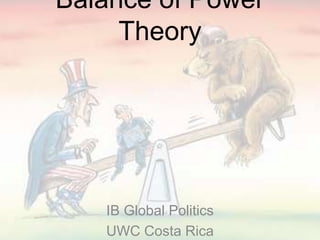Balance of power presentation
•Transferir como PPTX, PDF•
16 gostaram•20,954 visualizações
Global Politics IB
Denunciar
Compartilhar
Denunciar
Compartilhar

Recomendados
Recomendados
Mais conteúdo relacionado
Mais procurados
Mais procurados (20)
International relations(Introduction and its Theories)

International relations(Introduction and its Theories)
Destaque
Destaque (16)
Liberalism theory,Types of liberalism,and criticism

Liberalism theory,Types of liberalism,and criticism
Semelhante a Balance of power presentation
Semelhante a Balance of power presentation (20)
Underlying Causes of War PPT: Trichotomy of Conflict and Levels of Analysis

Underlying Causes of War PPT: Trichotomy of Conflict and Levels of Analysis
Slide 9 WestCal Political Science 5 Western Political Thought 2016

Slide 9 WestCal Political Science 5 Western Political Thought 2016
Soft power: A conceptual appraisal of the power of attraction

Soft power: A conceptual appraisal of the power of attraction
Week 8 - Counterterrorism and Counterinsurgency.pdf

Week 8 - Counterterrorism and Counterinsurgency.pdf
Mais de bentogo
Mais de bentogo (9)
Último
https://app.box.com/s/7hlvjxjalkrik7fb082xx3jk7xd7liz3TỔNG ÔN TẬP THI VÀO LỚP 10 MÔN TIẾNG ANH NĂM HỌC 2023 - 2024 CÓ ĐÁP ÁN (NGỮ Â...

TỔNG ÔN TẬP THI VÀO LỚP 10 MÔN TIẾNG ANH NĂM HỌC 2023 - 2024 CÓ ĐÁP ÁN (NGỮ Â...Nguyen Thanh Tu Collection
Último (20)
ICT role in 21st century education and it's challenges.

ICT role in 21st century education and it's challenges.
ICT Role in 21st Century Education & its Challenges.pptx

ICT Role in 21st Century Education & its Challenges.pptx
Unit-IV; Professional Sales Representative (PSR).pptx

Unit-IV; Professional Sales Representative (PSR).pptx
Vishram Singh - Textbook of Anatomy Upper Limb and Thorax.. Volume 1 (1).pdf

Vishram Singh - Textbook of Anatomy Upper Limb and Thorax.. Volume 1 (1).pdf
Salient Features of India constitution especially power and functions

Salient Features of India constitution especially power and functions
TỔNG ÔN TẬP THI VÀO LỚP 10 MÔN TIẾNG ANH NĂM HỌC 2023 - 2024 CÓ ĐÁP ÁN (NGỮ Â...

TỔNG ÔN TẬP THI VÀO LỚP 10 MÔN TIẾNG ANH NĂM HỌC 2023 - 2024 CÓ ĐÁP ÁN (NGỮ Â...
Balance of power presentation
- 1. Balance of Power Theory IB Global Politics UWC Costa Rica
- 2. Key Point National security is strengthened when military capability is distributed so that no single state can dominate all others
- 3. Balance of Power Theory is a realist theory
- 4. Key assumptions of realist theories • International order is anarchic • Primary goal of all actors is survival • Power is relative
- 5. What happens if one state becomes stronger? According to Balance of Power Theory, that state will take advantage of its strength and attack weaker neighbours This provides an incentive for those threatened to join each other in a defensive coalition
- 6. How might states counter an external threat? • When faced with an external threat from a more powerful state, states have several options: – Balancing – Bandwagoning – Buck-passing – Blood-letting
- 7. Balancing Balancing encompasses the actions that a particular state or group of states take in order to equalise the odds against more powerful states (make it more difficult and hence less likely for powerful states to exert their military advantage over the weaker ones)
- 8. Two types of balancing Internal Balancing • Internal balancing involves efforts to enhance state's power by increasing one's economic resources and military strength in order to be able to rely on independent capabilities in response to a potential hegemon and be able to compete more effectively in the international system External Balancing • External balancing involves strengthening and enlarging one's alliances and interstate cooperation in order to prevent a hegemon or counter a rising power.
- 9. Bandwagoning A state aligns with a stronger, adversarial power and concedes that the stronger adversary-turned-partner disproportionately gains in the spoils they conquer together Question: Why would a state choose to bandwagon instead of balance?
- 10. Buck-passing • Instead of balancing against an aggressor, some states instead choose to "pass the buck" whereby instead of taking action to prevent a potential hegemon's rise, it will pass the responsibility on to another state • Mearsheimer argues there are 4 strategies states can use to facilitate buck passing
- 11. One: • Seeking good diplomatic relations with the aggressor in the hope that it will divert its attention to the "buck-catcher”
- 12. Two: • maintaining cool relations with the buck- catcher so as not to get dragged into the war with the buck-catcher and as a result possibly increase positive relations with the aggressor
- 13. Three: • increasing military strength to deter the aggressive state and help it focus on the buck-catcher
- 14. Four: • facilitating the growth in power of the intended buck-catcher
- 15. Blood-letting If a state is an enemy with both the aggressor and the intended buck-catcher, a buck-passer can implement a bait and bleed strategy whereby the state causes two rivals to engage in a protracted war while the baiter remains on the sideline. Bloodletting, a further variant whereby a state does what it can to increase the cost duration of the conflict can further increase the buck-passer’s relative power Question: Why might states prefer bloodletting and buck passing to balancing?